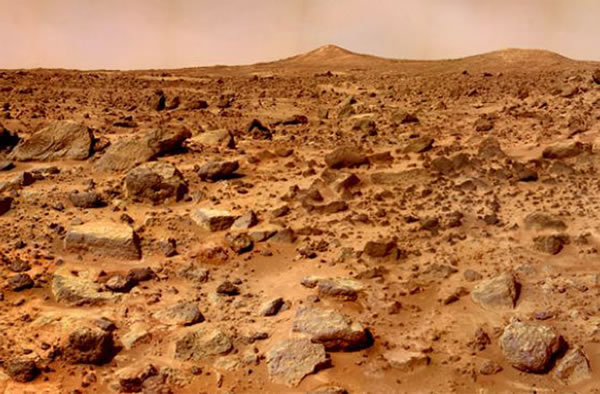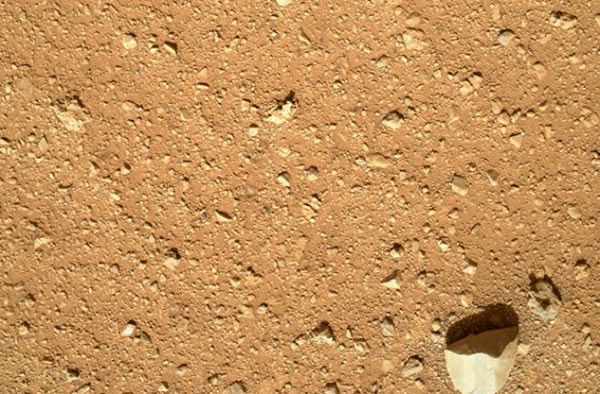Mars Probe to Study How Planet Lost Its Water
The dry Martian landscape, as seen by Pathfinder in 1997.
A view of the dry ground immediately in front of the Curiosity Mars rover.
A robotic detective of sorts is being dispatched to Mars to try to crack a long-standing mystery of why a planet that seems to have once been Earth’s twin, with oceans, rivers, rain and snow, ended up a cold desert.
"We know for a fact that it used to be very different. Mars used to have a wet climate ... but over billions of years that changed," said astronomer Michelle Thaller, with NASA's Goddard Space Flight Center in Greenbelt, Md.
Scientists believe the climate change happened because Mars lost its magnetic shield, leaving the planet vulnerable to solar and cosmic radiation. Over time, the ionizing rays took apart what was believed to have been a thick, protective atmosphere which kept Mars warm and wet.
NASA's Curiosity rover and other probes have given scientists a glimpse of ancient Mars by analyzing its rocks. The new scout, called MAVEN, will study what remains of Mars' atmosphere to learn about processes that are going on today.
"We'll get a window on what is happening now so we can try and look backward at the evidence locked in the rocks and put the whole story together about Martian history and how it came to be such a challenging environment," said Pan Conrad, a deputy principal scientist on the Curiosity mission.
MAVEN, an acronym for Mars Atmosphere and Volatile Evolution Mission, is designed to spend at least on year circling Mars, focusing not on the planet’s surface but on the thin layer of gases that remains in its skies.
Scientists want to know how cosmic rays and high-energy particles from the sun, which blast out into space during solar flares and powerful storms, peel away Mars’ atmosphere and how often the damage occurs.
One of MAVEN's three science instruments is a near-copy of one of Curiosity's gas analyzers, allowing the spacecraft to inhale the atmosphere and reveal its chemical composition.
The information should help scientists home in on the time in Mars’ history when conditions were most suitable for life.
"If live arose on Mars it probably did so early, within about 500 million years," of its formation, Conrad said.
Earth had some key advantages that allowed it to keep its magnetic field and evolve into a mecca for life.
First, Earth is larger. Mars' diameter is about half the length of Earth's and it has just 10 percent Earth’s mass.
Being smaller meant Mars lost some of its inner heat faster than Earth, a process that may have directly or indirectly led to the disappearance of Mars' magnetic field some 4 billion years ago.
Mars also does not have a large moon like Earth's. Scientists believe the moon helped shield Earth from the heavy bombardment of asteroids and comets that pummeled the inner planets 3.8 billion to 4.1 billion years ago. Being closer to Jupiter also may have forced Mars to bear a greater share of the incoming asteroid strikes.
Those impacts may have been sufficient to warm Mars' surface and shut down convection in its core, another possible explanation for loss of the planet's magnetic field.
"Without that protection, the atmosphere moved away and then there was no way to moderate the conditions so that Mars could stay warm enough to have a surface that looks more like Earth’s," Conrad said.
MAVEN is slated for launch aboard an Atlas 5 rocket at 1:28 p.m. EST on Monday from Cape Canaveral Air Force Station in Florida. The journey to Mars will take 10 months.(Nov 15, 2013 01:38 PM ET // by Irene Klotz)













